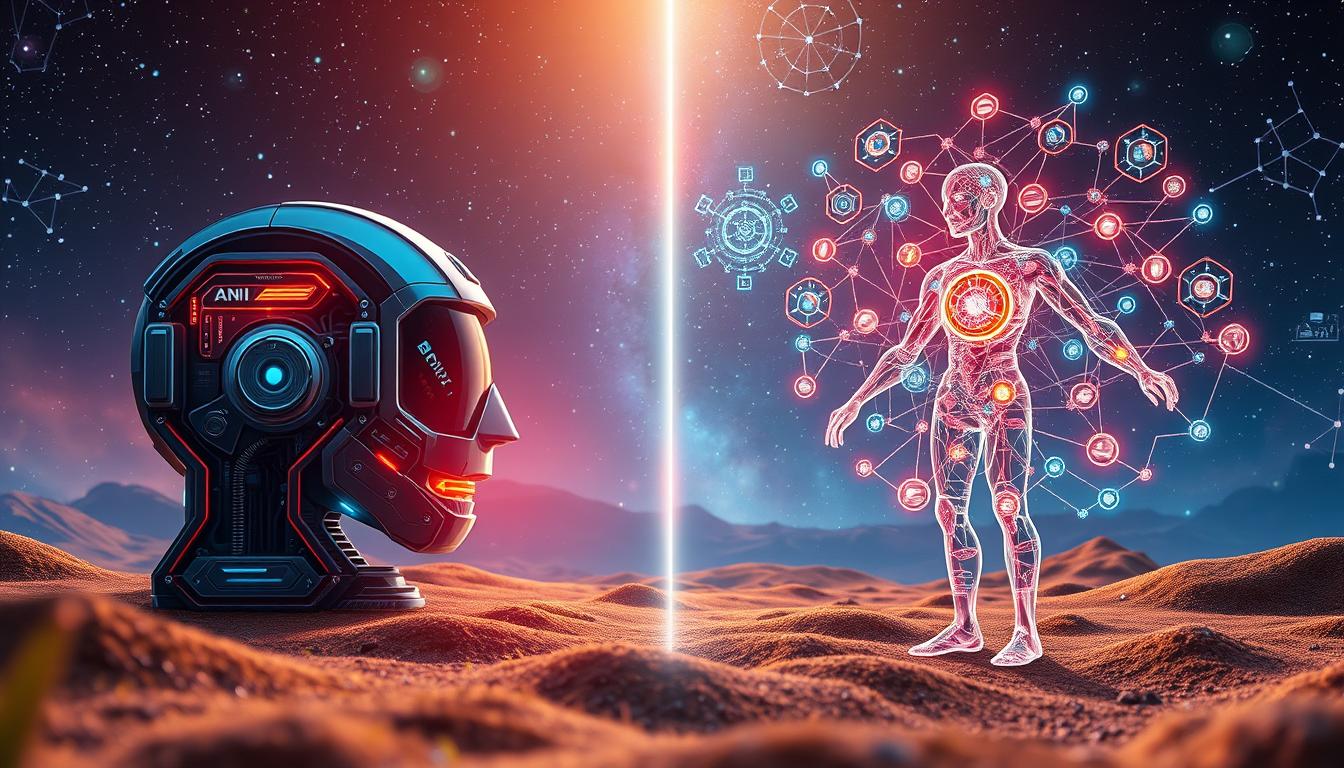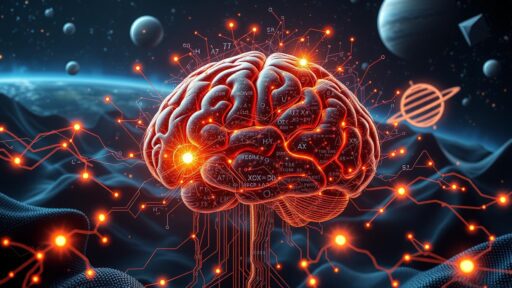In the fast-changing world of artificial intelligence (AI), we’re amazed by machines that can think like us. They use natural language processing and are our virtual assistants. AI is now a big part of our lives, changing how we use technology. It’s important to know the different kinds of AI intelligence.
Artificial Narrow Intelligence (ANI) and Artificial General Intelligence (AGI) are two main types of AI. ANI is great at certain tasks, like image recognition or fraud detection. But AGI wants to be as smart as humans, able to learn and solve tough problems. As we explore this area, we wonder: how do these AI types differ, and what will they mean for our future?
Key Takeaways
- Artificial Narrow Intelligence (ANI) is designed to perform specific tasks through machine learning algorithms.
- Artificial General Intelligence (AGI) aims to replicate human-level intelligence and adapt to new situations.
- AGI has the power to change many industries, from healthcare to transportation.
- Artificial Super Intelligence (ASI) is a thought of AI that is smarter than humans.
- It’s key to develop AI responsibly to make sure its good points are more than its bad.
What is Artificial Intelligence?
Artificial Intelligence (AI) is a field that mixes machine learning and advanced systems. It aims to act like human intelligence. This includes natural language processing, chatbots, and virtual assistants. AI could change how we use technology.
Defining AI and Its Capabilities
AI lets machines learn, reason, and do tasks that need human smarts. They can predict, decide, and even think like humans. AI systems solve complex problems and adjust to new situations. They are very useful in many industries.
The Excitement Around AI and Its Future
AI is exciting because of its many possibilities. It teaches machines to learn and act like humans. This opens up new areas in human-AI collaboration, ai-powered interaction design, and conversational AI.
AI could make our interactions with technology better. It will use voice interfaces and intelligent user interfaces. This could solve real-world problems in new ways.
The future of AI is full of multimodal interaction possibilities. Machines will use speech, text, and gestures to communicate. This could make artificial intelligence human computer interaction more natural and effective.
Exploring the Three Types of Artificial Intelligence
Artificial intelligence (AI) is changing fast and exciting many people. It’s key to know the different AI types and what they can do. AI is split into three main types: Artificial Narrow Intelligence (ANI), Artificial General Intelligence (AGI), and Artificial Superintelligence (ASI).
Artificial Narrow Intelligence (ANI) is the most common AI today. ANI systems are great at one thing, like playing chess or driving a car. But they can’t do everything like humans can. Siri and Alexa are examples of ANI, helping with simple tasks.
Artificial General Intelligence (AGI) wants to be as smart as humans. AGI systems can learn and do many things, like humans. But making AGI is a big challenge, and we haven’t made any yet.
Artificial Superintelligence (ASI) is the most advanced AI idea. ASI would be smarter than humans in everything, including emotions. But making ASI worries many, as it could be too powerful for us.
Looking at these AI types, we see they have different powers and effects on our lives. As AI grows, it will change our future. We must be both excited and careful about these changes.
Artificial Narrow Intelligence (ANI)
Artificial Narrow Intelligence, or weak AI, is made to do specific tasks. It’s not as smart as humans. It can only do what it’s programmed to do.
The Capabilities and Limitations of ANI
ANI is great at certain tasks like recognizing speech or playing chess. But it can’t solve problems like humans do. It can’t learn new things outside its training.
Real-World Examples of ANI Applications
- Virtual assistants like Siri and Alexa are good at voice commands and web searches. But they can’t have deep conversations or learn new things.
- Chatbots for customer service can answer simple questions. But they can’t understand complex human interactions.
- Self-driving cars can drive and avoid obstacles. But they need lots of training for each situation.
- Natural language processing algorithms can make text seem human-like. But they only understand what they’ve been trained on.
ANI has improved a lot and is everywhere in our lives. But it’s not as smart as true artificial general intelligence (AGI). It lacks the wide range of intelligence and flexibility needed for AGI.
ani vs agi
Artificial intelligence (AI) is growing fast. It’s key to know the different types of AI and what they can do. Two main types are Artificial Narrow Intelligence (ANI) and Artificial General Intelligence (AGI).
ANI, or “weak AI,” is great at specific tasks. For example, it can play chess or recognize faces. But it can’t use its knowledge in other areas. Virtual assistants like Siri or Alexa, and image recognition software are examples of ANI.
AGI, or “strong AI,” is the dream of AI research. It aims to have human-level intelligence. AGI can learn, understand, and solve problems in many areas. It’s like having AI that can think and reason like us.
The main difference is in their intelligence and flexibility. ANI is specialized and only works within certain limits. AGI wants to be as flexible and smart as humans, maybe even smarter in some ways.
Working towards AGI is a big challenge, but it could bring huge benefits. It could help in science, technology, and solving big social problems.
In short, ANI and AGI show how AI is changing and growing. We’re trying to make AI that can think and act like us. Understanding these differences is important as we use AI in our lives.
Artificial General Intelligence (AGI)
The search for Artificial General Intelligence (AGI) is very exciting. AGI, or “human-level AI,” wants to make machines as smart as us. They should be able to see, learn, think, and solve problems like we do.
The Pursuit of Human-Level AI
Many people are dreaming of AGI. Artificial intelligence human computer interaction and natural language processing are key to making this dream real. Chatbots, virtual assistants, and voice interfaces are showing us how AI can help us talk and work better together.
Current Efforts and Challenges in AGI Development
Even though AGI is far away, big companies are spending a lot of money on it. Microsoft, OpenAI, and others are working hard to make AI smarter. But, making AI as smart as us is very hard. They need to get better at learning, understanding, and making choices on their own.
Artificial Superintelligence (ASI)
Artificial Superintelligence (ASI) is a dream for many. It’s a type of AI that’s smarter than the smartest humans. This AI is thought to be beyond what we can imagine.
Imagine a machine that can do anything better than us. It could solve problems and make decisions like a super genius. This is thanks to large language models (LLMs), multisensory AI, neural networks, and evolutionary computation.
Potential Benefits and Risks of ASI
Experts are both thrilled and scared about ASI. They think it could solve big world problems and make new discoveries. But, there are also big worries.
- One big worry is losing control to these super smart machines.
- Another worry is how fast things could change with intelligent user interfaces and ai-powered interaction design.
- It’s important to make sure ASI is used right. We need to make sure it fits with what’s good for humans.
Artificial Superintelligence is a big dream in AI. It makes us think about what the future holds. It’s a topic that gets everyone talking.

Comparative Analysis of AI Types
Exploring artificial intelligence, we find three main types: Artificial Narrow Intelligence (ANI), Artificial General Intelligence (AGI), and Artificial Superintelligence (ASI). Each can forecast and adapt, make decisions, and replicate human intelligence. But they differ in many ways.
Capability to Forecast and Adapt
All AI types use algorithms to spot data patterns. They then predict and adapt based on this. ANI uses set data for choices. But AGI and ASI might make decisions faster than humans.
Ability to Make Decisions
AI’s decision-making skills are growing. ANI is great at tasks like chess or driving. But AGI and ASI could make more complex decisions in the future.
Replicating Human Intelligence
All AI types aim to mimic human smarts. They want to understand tasks, respond well, and solve problems like humans. ANI does well in certain areas. But AGI and ASI aim for human-like problem-solving skills in many areas.
The field of artificial intelligence human computer interaction, natural language processing, chatbots, virtual assistants, voice interfaces, intelligent user interfaces, human-ai collaboration, ai-powered interaction design, conversational ai, and multimodal interaction is always changing. Studying these AI types helps us understand their current and future roles.
Ethical Considerations and Responsible AI Development
Artificial intelligence (AI) is changing fast. We must focus on safety and responsible use to make sure it helps everyone. AI has grown from artificial narrow intelligence (ANI) to artificial general intelligence (AGI) and even artificial superintelligence (ASI). It’s important to think about the good and bad sides of AI as we move forward.
AI might change jobs for many people. A report says up to 30% of jobs could be automated by 2030. This could affect 375 million workers. We need to help people get new skills and jobs.
AI systems can be unfair if they’re not made right. Experts like Fei-Fei Li say we need to make AI fair and open. Groups like the “Partnership On AI” are working on rules for making AI better.
We must be careful and thoughtful as we make AI. We should focus on safety, being open, and helping people. This way, AI can really help us all. The future of human-AI collaboration, conversational AI, and multimodal interaction depends on it.
- 50% of governments worldwide are predicted to implement responsible AI by 2026 through policies, regulations, and data privacy.
- China’s Taichi-II chiplet, predicted to power super-intelligent AI models, was unveiled in April 2024.
- Artificial general intelligence (AGI) is a theoretical field of AI research where developers are working on improving machine intelligence that can complete new tasks for which it has never received training.

The Future of AI and Its Impact on Society
Artificial intelligence (AI) is growing fast. It will change how we use technology and talk to each other. We’re moving from simple AI to more advanced forms.
Most experts think AI will make society better. They spend over $20 billion on AI products. This shows they believe in AI’s power.
AI is already changing jobs. For example, the Associated Press uses AI to write thousands of stories. This is four times more than before.
AI is getting better at talking to us. It’s making artificial intelligence human computer interaction and natural language processing better. We’ll see smarter chatbots and virtual assistants soon.
We’re aiming for AI that can do anything a human can. But this raises big questions. We need to make sure AI works well with humans.
AI will change our world a lot. We must keep up with new AI and learn how to use it right. This way, AI and humans can work together well.
Conclusion
Looking back at our journey through artificial intelligence, I’m amazed by the progress. We’ve seen big steps in artificial intelligence human computer interaction, natural language processing, and more. The goal of reaching Artificial Narrow Intelligence (ANI), Artificial General Intelligence (AGI), and Artificial Superintelligence (ASI) is a big leap forward.
Each type of AI brings its own changes and chances to shape our world. But we must focus on making AI safe and responsible. This way, these new technologies can truly help us all.
AI’s real strength is in making our lives better, solving tough problems, and expanding our knowledge. By choosing to develop AI in a responsible and ethical way, we can create a future full of possibilities. This future will be better for all of us, for years to come.
Source Links
- The 3 Types of Artificial Intelligence: ANI, AGI, and ASI – viso.ai
- Understanding ANI, AGI, and ASI in Artificial Intelligence
- What are the different types of artificial intelligence? – University of Wolverhampton
- The Future of AI: What Is AGI? AI vs AGI vs ASI | GPT-5 AGI & OpenAI’s ‘o1’
- 2. Types of AI
- Artificial General Intelligence (AGI): Definition, How It Works, and Examples
- The Three Types of Artificial Intelligence: ANI, AGI, and ASI — Discovering the World of AI 🤖🧠
- Understanding the Three Types of Artificial Intelligence: ANI, AGI, and ASI
- ANI vs. AGI vs. ASI
- Is ChatGPT Considered a ANI or AGI?
- What are the 3 types of AI? A guide to narrow, general, and super artificial intelligence
- AI, ANI, AGI, ASI…What?!
- Marketer’s Guide to ANI, AGI, and ASI – Eight by Eight
- ANI, AGI and ASI – what do they mean? – Learning & Development Advisory
- The Stages and Categorizations of AI — EITC
- Artificial general intelligence
- What Is Artificial Superintelligence? | IBM
- General AI vs Narrow AI
- Narrow AI vs. General AI vs. Super AI
- What Is AI and AGI? Differences, Future, and More
- Artificial General Intelligence vs Generative AI: Which is the Future?
- Artificial Intelligence (ANI & AGI) and its impact on society | MS&E 238 Blog
- The Future of Artificial Intelligence and Its Impact on Society
- The 3 Stages of AI – Gemmo.AI
- AGI vs. other types of AI: What’s the difference?
- Difference between: ASI vs AGI vs ANI
- Understanding the Three Types of Artificial Intelligence: ANI, AGI, and ASI | Shahabuddin Amerudin @ UTM
- Artificial Intelligence Advancements | Knowledge Ridge




